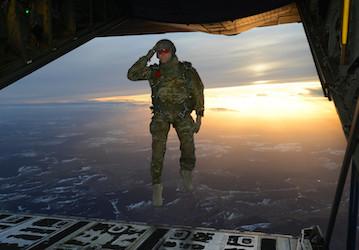The U.S. Army deploys to and trains in a broad range of challenging environments. This collection of Army bulletins, studies, and web pages provide in-depth information on operating in heat, in cold, and at altitude.
Heat
Heat stress control and heat casualty management [PDF]
TB MED 507 (2003) is the Army’s most recent Technical Bulletin related to the management of heat-related issues. It covers physiologic responses to heat, management of heat stress (including work-rest cycles, fluid and electrolyte replacement, and acclimatization), and the recognition and treatment of heat illness and injury (heat exhaustion, exertional heat injury, rhabdomyolysis, stroke, etc.).
APHC heat illness fact sheet [PDF]
This 2-page fact sheet from the Army Public Health Center summarizes some of the major issues associated with heat illness, including categories, causes, risk factors, and symptoms. For more detail about issues associated with operations in the heat, see the link provided for TB MED 507.
Heat-related illness prevention
This Army Public Health Center web page includes links to articles, fact sheets, policy and guidance documents, and training materials for the prevention and treatment of heat-related illness, with a link to order pre-printed posters, tip cards, and more from the APHC e-catalog.
Cold
Prevention and management of cold-weather injuries [PDF]
TB MED 508 (2005) is the most recent Army Technical Bulletin on the prevention of injury related to cold environments, including adaption to cold, management of cold stress (hypothermia, frostbite, etc.), food and fluid requirements, identification and treatment of cold injury, and cold-weather clothing.
Sustaining health and performance in the cold [PDF]
Written in 1992, USARIEM Technical Note 92-2 contains medical guidance for cold-weather operations that is still pertinent to sustaining health in cold, sun, wind, rain, snow, and low humidity. Recommendations apply to food and water requirements, treatment of injuries, management of tasks and operations, preparation and training for deployment to cold-weather locations, wind chill assessment, and a cold-weather survival kit for individuals.
Altitude
Altitude acclimatization and illness management [PDF]
This U.S. Army Technical Bulletin (TB MED 505, 2010) covers the myriad issues associated with ascending to and operating at high altitude. Issues include adaptation to altitude, managing risk of illness, identifying and treating altitude illness, and limitations of physical, neurological, and mental performance at altitude.
A Soldier’s Guide to Staying Healthy at High Elevations [PDF]
USAPHC and USARIEM produced this guide to the threats associated with high-altitude operations and protective measures to minimize disease and nonbattle injuries. Topics include cold, sun-exposure, terrain, and carbon-monoxide injuries; altitude acclimatization and illnesses; altitude-associated dehydration and sleep disturbances; psychological effects of altitude exposure; and as infectious diseases associated with altitude.
Altitude acclimatization guide [PDF]
The Thermal & Mountain Medicine Division of USARIEM produced Technical Note TN04-05 in 2004, with detailed information about hypoxia at high altitude, performance and health issues, acclimatization (including monitoring and assessment), staging and slow ascent profiles, and supportive interventions. Figures and tables include technical information not available elsewhere.
Altitude effects on the human body
APHC maintains this web page with the latest information about how operating at altitude affects the human body, with discussions of how altitude reduces physical and psychological performance; the increased risk of dehydration; the effects of nutrition, tobacco, alcohol, and caffeine; and methods to acclimatize to altitude. Also on this page are links to additional articles and Army documents.
